Chapter 1
Selecting, Buying, and Activating Your iPhone
Now that Apple's iPhone has been out for a number of years, you may have seen horror stories in the press about how an iPhone is going to cost you thousands of dollars over its lifetime. You have to buy the iPhone, pay for activation, and fork out money for expensive monthly service voice, data, and text plans (not to mention taxes and other fees). If you decide to back out any time during the standard two-year mobile phone contract, you're going to hand over even more money in early termination fees.
Well, there's more than a grain of truth to what you read. Since you're going to be spending a couple thousand dollars over the next few years, you need to know what you're doing when you buy that iPhone. If you're weighing the choice of whether to purchase an iPhone and trying to figure out exactly how much you're going to be paying, this chapter is for you. You'll also discover the down-and-dirty secrets of iPhone activation, plan selection, and even return policies. This chapter contains all the basic facts you need to select, buy, and activate your iPhone.
Selecting Your iPhone
At any given time, there are relatively few models of iPhones available. As of the publication of this book, all of them come with iOS 5, representing a new generation of the operating system software that powers the features of the iPhone. Usually you'll see an entry-level iPhone or two with fewer features and less storage, as well as a new top-of-the-line model.
How do you choose the model that's right for you? It all comes down to two factors: cameras and storage. The iPhone 4S has a high-resolution 8-megapixel camera with a flash that can shoot 1080p high-definition (HD) video, while the original iPhone 4 has a 5-megapixel camera (also with a flash) that will shoot 720p HD video. If you don't need a front-facing camera that allows you to take self-portraits or make FaceTime video calls, you can even get an iPhone 3GS with a 3-megapixel camera. As for storage, you need to decide whether you want to double the purchase price of your phone for a few more gigabytes of storage. I recommend getting as much storage as you can. If you load a lot of movies and videos onto your device, you can run out of space on a top-of-the-line iPhone very quickly.
The iPhone 4S tops out storage at a whopping 64 GB, while the iPhone 4 and iPhone 3GS are now available with only 8 GB of storage. iPhone 4S devices are also available in 16 GB and 32 GB models.
Here are some questions to ask yourself while selecting the model of iPhone to purchase:
How big is your music library? If your library is small, a unit with less storage might be fine. If it's large, the extra space on some iPhone models helps to store additional music and podcasts.
How many videos do you want to carry around? A single two-hour movie may occupy more than a gigabyte of storage. If you travel a lot, especially on airplanes, you may want to pay more to store additional movies and TV shows with those extra gigabytes.
Do you plan on using your iPhone as your primary camera and camcorder? If you do, then look at the more sophisticated models with higher resolution, flash, and HD video capabilities. If you already carry a digital camera or camcorder with you on a regular basis or don't frequently shoot photos or video with your existing phone, a free (in many countries) iPhone 3GS or low-cost iPhone 4 may be fine. For budding videographers who plan to take a lot of HD video or photographers who want the best possible optics and resolution, the iPhone 4S is the right choice.
Is the thought of making video calls exciting to you? For some people, just answering a regular cell phone call is a challenge. But if you love to have regular face-to-face conversations with friends and relatives, then you may want to consider theiPhone 4 or 4S with the built-in FaceTime video-calling feature and front-facing camera.
Do you need to carry lots of data? Many iPhone apps use iTunes data storage and can synchronize files with your computer. Whether that data consists of presentation slideshows, project management files, or some other information that you need at your fingertips, the size of the data being stored can add up quickly. If you think you might need to do this, maybe the extra gigabytes on a more expensive iPhone model could be put to good use.
How long do you intend to keep this iPhone? If you're an early adopter who likes to trade up at the earliest possible opportunity whenever Apple offers a new model of iPhone, you may want to “buy in cheap” each time the new models are released and sell your old iPhone on the aftermarket. If you'd rather get the most use out of the iPhone over the longest period of time, then paying more up front means you won't outgrow the iPhone quite as fast.
Considering System Requirements
With the release of the fifth-generation iPhone operating system, iOS 5, you no longer need to think about your computer system requirements. In fact, iOS 5 makes it possible to live in a post-PC world—use an iPhone for your mobile device and an iPad for work requiring a larger screen, synchronize the two through Apple's iCloud, and everything works out beautifully.
However, you'll most likely want to synchronize your iOS 5 phone with either a Mac or a PC, since most people still own personal computers and want to keep all of their devices synced with the latest information. To do so, you'll want to have iTunes installed on your Mac or Windows PC in order to have control over the various synchronization options.
For the versions of iTunes available at the time of publication, the computer system requirements are as follows:
- A Mac computer running OS × 10.5, or a Windows computer with Windows 7, Vista, or XP Home or Professional with Service Pack 2 or newer.
- iTunes Store account.
- Broadband Internet access to use the iTunes Store.
- If you own an older computer, you may want to check the latest hardware requirements for iTunes at
www.apple.com/itunes/download.
Buying Your iPhone
Once you've decided what iPhone model to buy (Figure 1–1), you're probably ready to pull out your credit card and buy that phone as quickly as possible. So, where you should buy it? At an AT&T store or at an Apple Store?A “big box” store like Best Buy? How about a discount store like Target or Walmart? Or should you purchase it online? You might be surprised to learn that your choice does matter.
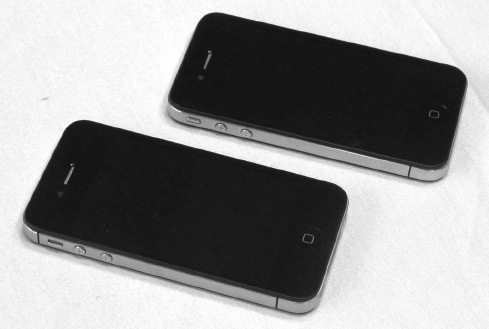
Figure 1–1. The Apple iPhone 4S (bottom) and iPhone 4 (top) are typical of the models of iPhones available at any particular point in time.
Although it's possible to purchase an iPhone from any number of online stores, I recommend buying your iPhone in person at a store. You can ask questions. You can make human connections. You can have your iPhone activated and ready for calling when you leave the store. If something goes wrong with your purchase, you have a person who's there to help you work through it.
The sad fact of the matter is that a significant, although small, percentage of iPhone purchases go awry. Some people end up with a screen flaw, such as dead screen pixels. It's not an uncommon problem, and if found soon after purchase, it may involve a trade-in for a new unit. Others may have problems with their antennas or with activating their service. The chances of resolving these issues may be better if you have a real person to help.
As for the question of Apple or a carrier, I lean slightly toward buying at an Apple Store. It's an Apple product you're buying, and the Apple staff members are more knowledgeable about their products. Apple employees are happy to activate and set up your iPhone for you.
Apple Stores usually replace defective iPhones regardless of their point of purchase, and if you have problems with your phone service, you can go to any of the carrier's store locations whether you purchased your phone there or not; it's the service you're dealing with, not the physical iPhone unit.
Returns and Exchange Policies
The return policy for iPhones has improved since the release of the phone. If you're not happy with your iPhone purchase, you can return the undamaged phone to an Apple Store or the Apple online store within 30 days of purchase for a full refund. You must return the phone in the original packaging, including all the accessories, manuals, and documentation, and you won't be charged a restocking fee.
If you purchased your iPhone at a cellular carrier store, things aren't as rosy. A restocking fee will generally be applied to the return, unless you purchased it without service and the phone box was never opened.
As for discount and “big box” stores, the return and exchange policy varies. Before you make your purchase, be sure that you know exactly how returns and exchanges are handled. My personal preference is to get that policy in writing; it's usually printed out on the receipts that accompany your purchase.
Any return might involve an early termination fee (ETF) being levied against you by your cellular carrier. iPhones are available on many different carriers around the world. I recommend talking with your carrier or at least visiting their web site to determine the exact return policy and applicable ETF for your situation. An ETF can be quite expensive—for AT&T Wireless, canceling your contract after 30 days can cost you $315.
Bringing Home Your iPhone
Once you buy your iPhone, it's time to take it home, unpack it, and set it up. iPhone packaging (see Figure 1–2) is a small work of art. The iPhone ships in a box containing the phone, a USB connector cable, a USB power adapter, those famous white earbuds, and a packet of documentation. Each of these items is important and will help you in your day-to-day use.
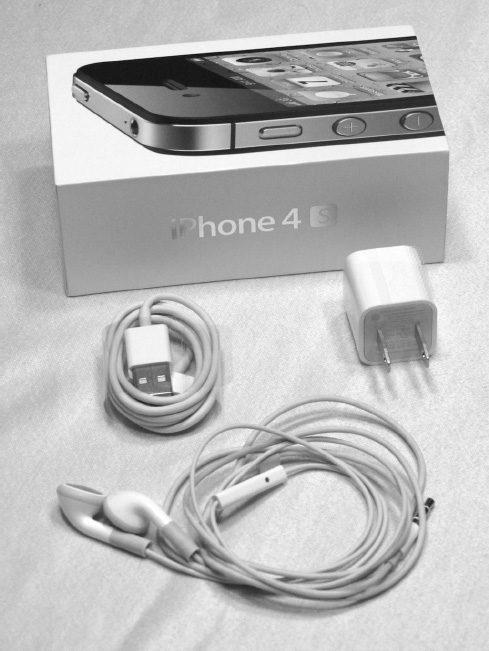
Figure 1–2. The content of that nice iPhone box usually consists of a USB-to-dock connector cable (left), a USB power adapter (right), and a stereo headset (bottom). You can find your complimentary Apple sticker in a packet inside the box.
Cable: The USB cable attaches your iPhone to either your computer or the USB power adapter. With past versions of the iPhone, the cable was useful for charging the battery and for activating and syncing the phone. Now it's possible to activate your phone without syncing to a computer, but you'll still need to use the cable for charging.
USB power adapter: The power adapter included with your iPhone plugs directly into the wall and allows you to charge your iPhone. It offers a single USB port. To use it, just connect your iPhone to the adapter using the USB cable. The adapter supplies the 5 volts required for powering USB devices. Third-party power adapters are also available for charging multiple devices or charging in an automobile.
Stereo headset (earbuds): The earbuds included with the iPhone differ slightly from those included with iPods. This stereo headset contains a built-in microphone and switch. The microphone allows you to take calls on your iPhone without holding the phone up to your ear, and the switch allows you to end calls as well as control music playback. The switch is also used to initiate the Siri Intelligent Assistant or Voice Control of your iPhone.
NOTE: The features of older or newer models of the iPhone may vary from what you see in the following feature overview.
iPhone 4S Feature Overview
The iPhone 4S is similar to earlier iPhones in terms of external features. The top of the iPhone houses a jack into which you can plug your earbuds and a Sleep/Wake button that is used to power on and off certain features. The bottom of your iPhone has a built-in speaker and microphone and an indented slot for connecting to a dock or USB cable. The iPhone's front has a receiver (earpiece) on top, which you use to listen to phone calls, a large touch screen, and a single Home button. On the right side of the iPhone as you look at the screen is a Subscriber Identity Module (SIM) tray where your phone's SIM card is stored. You do not see the interactive screen shown in Figure 1–3 until you have activated your iPhone.
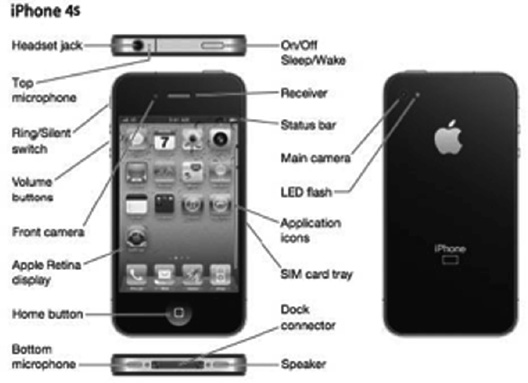
Figure 1–3. iPhone 4S feature overview
Activation at the Store
If you purchase an iPhone at an Apple or cellular service provider store in the Apple Stores in the United States and many other countries, you'll find that the activation process is taken care of in the store at the time you pay for the phone.
After you've made your choice as to the model of iPhone you want to purchase and have picked out accessories (cases, cables, and other goodies) to go with it, it's time to pay for the goods. When the Apple Store associate scans the iPhone box with ani OS-based point-of-sale device, the device immediately starts asking questions that you'll need to answer. Among those questions are the following:
- Are you a current customer of a particular mobile phone company that features the iPhone? If so, what is your telephone number?
- Are you coming over from another cell phone company? If so, what company, and what is your telephone number?
- What voice, data, and text plan would you like to sign up for?
- If you are not eligible for a phone upgrade on your existing plan, are you willing to pay the extra cost to buy the unsubsidized phone? (Many carriers subsidize the cost of the phone, knowing that you'll more than pay them back in your monthly subscription fees.)
In the case of an existing iPhone owner upgrading to a newer iPhone, the point-of-sale device checks your existing phone number and immediately lets the Apple Store associate know whether you're eligible for an upgrade. There's usually a nominal fee associated with the upgrade, and you are asked whether you want to accept that fee. The associate then displays your existing voice, data, and text plans, and you are asked whether you want to stay with those plans or change to a different plan. Of course, you'll also need to swipe the credit card that you'll use to pay for the phone and the plan, and your signature is required on the point-of-sale device.
After you agree to the terms and conditions of the carrier's plan and the use of Apple's hardware and software, your new iPhone is activated. Note that if you have an existing phone, the service to it is cut off immediately.
Activating your iPhone at an Apple or a carrier store has another benefit. Most of the stores have a set of cables and special software that are used to transfer all your settings, data, addresses, photos, and more from your existing phone to the iPhone. This is especially important if you are getting your first iPhone and coming over from another phone platform.
Until the iPhone has been fully activated, you are not able to make calls except for emergency (911) calls. With iOS 5, activation can now be done completely on your iPhone without requiring synchronization to a computer. In the next section, I describe how to activate your phone through iTunes on a computer, and the “PC-free” activation follows that.
Preparing for Activation Through iTunes
You have unpacked your iPhone but haven't yet connected it to iTunes. Now is a good time to review the data on your computer. When your iPhone is activated for the first time, it synchronizes with iTunes and, depending on your computer, to your e-mail accounts, your calendars, and so forth. Before you begin, here are some items you may want to review and clean up so your iPhone begins life with the freshest possible data:
Contacts: The iPhone can sync with Microsoft Outlook 2007 or 2010 on Windows, Address Book, Outlook or Entourage on a Macintosh, and Yahoo! Address Book on the Internet. To prepare for your first sync, review your existing contacts, and make sure they're up-to-date with current phone numbers and e-mail addresses. If you use another program to manage contacts, consider migrating your contacts to one of these solutions. If you'd rather not, that's OK too. You can add contact information directly to your iPhone, although it's not as convenient as having the information automatically loaded for you.
Calendar: Your iPhone can synchronize with computer-based calendars just like it does with contacts. iPhone supports iCal, Outlook, Gmail, and Entourage calendars on the Mac and Outlook 2007 and 2010 calendars on Windows. Get your calendars into shape before your first synchronization, and you'll be ready to immediately manage your schedule both from your computer and from your iPhone.
E-mail: Your iPhone works with most e-mail providers including Yahoo! Mail, Gmail, AOL, and of course Apple's iCloud mail. If your e-mail provider uses the industry-standard POP3 and IMAP services, your service will work with iPhone. You may want to establish new accounts with these providers before you activate your iPhone. That way, they'll load onto your unit the first time you synchronize. You can always add new e-mail accounts later, but it's nice to have them all set up and available for use right away.
NOTE: iPhone owners who use Microsoft Exchange as an e-mail, contacts, and calendar server will be happy to hear that their phone can tie into a Microsoft Exchange ActiveSync server with no problems.
Media: Current iPhone models offer relatively small storage space when compared to, for example, iPod Classic's generous 160GB hard drive. To make the most of this limited space, set up playlists for your favorite songs and pod casts, and consider removing TV shows and movies from your device once you've watched them. You can storeall of your media in iCloud and download it when needed, so why load all items onto your iPhone at once? Since, in all likelihood, you won't be able to synchronize your entire media library to your new iPhone because of storage constraints, invest time now in organizing your media to find those items you most want to have on hand.
Software and OS: You should update to iTunes 10.5 or newer before you attempt to activate your iPhone. And, if you're using a Macintosh, updating your computer to Mac OS X 10.7 “Lion” ensures that you'll be able to take advantage of all the latest features. It is possible to run iTunes 10.5 on a Mac running OS X 10.5.8, so that is the oldest version of the Mac operating system that is usable with the iPhone. You can download the latest version of iTunes from Apple at
www.apple.com/itunes/download. Remember that the system requirements may change at any time, so be sure to check the web page mentioned earlier:www.apple.com/iphone/specs.html.iTunesaccount: Apple requires a current iTunes account to activate your iPhone. If you do not already have one, you must sign up for a U.S. account with the iTunes Store. This requires a U.S. address and credit card. Here are the steps you'll need to follow in order to create that new iTunes account:
- Launch the iTunes application, and wait for it to load.
- Locate iTunes Store in the sidebar on the left side of the iTunes window. Click iTunes Store, and wait for the store window to load. Your Windows computer or Mac must be connected to the Internet for this to happen, since all storefront information is stored on Apple's servers.
- Find and click the Sign In button in the top-right corner of the screen. iTunes displays the sign-in screen shown in Figure 1–4. If you currently have an iTunes account, enter your Apple ID and password, and then click the Sign In button to sign into iTunes. No iTunes account? Click the Create New Account button, and follow the remaining steps to create your iTunes account.
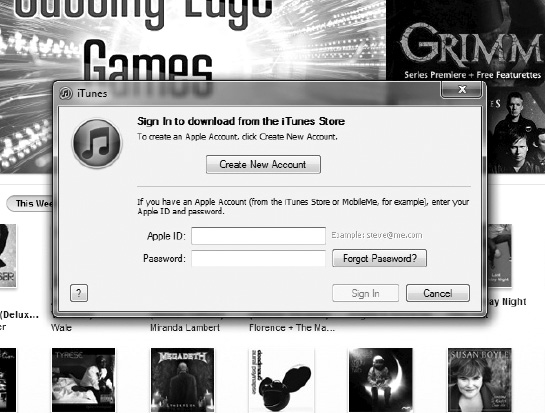
Figure 1–4. Use the iTunes Sign In window to access iTunes with your existing account or begin the process of creating a new account.
- Click Create New Account. The screen clears and displays a message welcoming you to the iTunes Store. Click Continue to start the process of creating your account.
- Review the terms of service, check the box that says “I have read and agree to the iTunes Terms and Conditions and Apple's Privacy Policy,” and then click Continue. A new window appears prompting you to create your account.
- Enter your e-mail address and a password. You must enter the password twice to verify that it was typed correctly. You also need to enter a security question—something only you would know the answer to, such as “What was the name of my third-grade teacher? or “What color was my first car?” Supply the answer to that question in the next space, and then enter your date of birth. Finally, review the questions about opting into e-mail notifications, and then click Continue.
- A payment information screen now appears. You'll need to enter a valid form of payment, either a credit card or a PayPal account. For a credit card, you must enter the card number, CVV number, and billing information. Those must match in order to complete account creation. If you choose to use PayPal, your web browser launches, and you're asked to log into the PayPal account to verify that you're a valid member. Finally, you can also choose to use an iTunes gift card or certificate as a form of payment by entering the redemption code on the card. Once the payment information has been entered, click the Continue button.
After following these steps, iTunes displays a screen congratulating you on creating the new account, and you'll also receive a confirmation e-mail at the address you specified during sign-up. The e-mail welcomes you to the iTunes Store and thoughtfully provides the customer service web address. In case you ever need it, that address is www.apple.com/support/itunes/.
Connecting Your iPhone to Your Computer
Once you have an active iTunes account, it's time to unpack your iPhone and connect it to your computer. Follow along with these steps of connecting to your computer in preparation for service activation:
- Remove the iPhone from its box, take off the plastic factory wrapping, and remove the USB-to-dock connector cable.
- Locate the two ends of the USB-to-dock connector cable. One is thin and marked with a standard three-pronged USB symbol, while the other is wide and marked with a rectangle with a line inside of it.
- Connect the thin end of the cable to a spare USB 2.0 port on your computer.
- Orient your phone with the screen facing you and the Home button pointing toward you (see Figure 1–5).
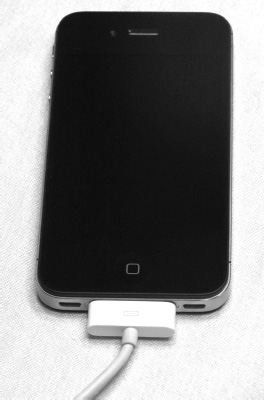
Figure 1–5. Plug the USB-to-dock connector cableinto the iPhone with the rectangle mark facing you.
- Locate the universal dock connector on the bottom of your iPhone. It's that rectangular hole about an inch wide that is located under the Home button. Gently yet firmly push the cable into the dock connector without twisting or forcing the connection. iTunes launches, and your iPhone should automatically power on.
If your iPhone doesn't automatically power on and display either a white Apple logo or a Connect to iTunes message, press and hold the Sleep/Wake button on the top of the iPhone—it's the button on the top right of the iPhone. After a few seconds, the iPhone should wake up and display the white Apple logo as it powers on. If the iPhone doesn't respond with some sort of message on the display, contact the store where you purchased the phone.
Activating Your iPhone (Nonstore Version)
Until you activate your iPhone, you won't be able to use it for anything except calls to emergency services. All you'll see initially is a prompt directing you to connect to iTunes. Activating the iPhone involves nothing more than selecting a service plan and registering your phone with your cellular carrier. In theory, this process is simple, and it works properly for the vast majority of new iPhone owners. However, if you're porting a number from another carrier or selecting a less popular plan, it can take a while to get your iPhone “on the air.”
TIP: If you run into significant delays during iPhone activation, call your carrier's customer service team. They'll usually refund the activation charge as a courtesy.
Since the process of activation varies somewhat depending on what mobile carrier you're using, I recommend following the prompts that are displayed on your iPhone screen. The activation process also changes over time, so I am not describing the process in detail here.
Your most important decision prior to activation is to select a monthly rate plan that provides a certain number of minutes of voice calling as well as text or multimedia messages and data transfer. These plans vary by carrier.
Voice Plans
Voice plans are for those times when you're not playing with your iPhone but instead having a conversation with others using the Phone app on your device. As an example, AT&T customers in the United States have a choice of several plans ranging from a low-cost minimum number of minutes per month (450) up to an unlimited calling plan. The difference in price between 450 minutes of talk time and unlimited was, at the time of publication, only $30. If you do a lot of talking, an unlimited voice plan may be perfect for you.
Cellular carriers often provide other features with the voice plans. Visual Voicemail, which is Apple's proprietary way of implementing a voice mail inbox on the iPhone that you can see and interact with, is included. Carriers may also provide rollover minutes, which means that unused plan minutes can be used in future months, as well as provide “free” night and weekend minutes in excess of the plan minutes.
If you're having difficulty making your mind up about a voice plan, consider how much total time you currently spend per month talking on your existing mobile or landline phone. Most cellular providers will provide you with exact usage statistics. Also consider if you're going to be replacing a landline with your new iPhone. Many people are doing this, and it can increase your monthly usage.
Regardless of the plan you select, know that most cellular carriers allow you to adjust your plans for more or less minutes while you're in a contract. They understand that your needs can change and are usually more than willing to provide you with a more or less expensive plan in order to keep you as a customer.
Data Plans
Data plans charge you for every little bit of information that you send or receive from your iPhone. Data is what you're consuming when you access the Internet, surf the Web, or check e-mail. Many cellular service providers sell “packages” containing a specific amount of data—say 200MB or 2GB—to be used during a month. If you use more, you're charged an extra amount for the extra usage. If you don't use all your data, you won't be able to carry over those extra megabytes.
How much data will you use in a month? That's dependent totally on what you use your iPhone for. For many users, 2GB of data transfer per month will be more than enough, especially if you're using your iPhone in an environment where you can use a Wi-Fi connection for most of your data needs. As with voice plans, many carriers offer a way to change your requirements up or down depending on your actual usage. Once you've used your iPhone for a few months, you'll be able to see your usage patterns and adjust accordingly.
There's one other feature that is offered by most carriers—Personal Hotspot. Personal Hotspot allows you to share the 3G data connection on your iPhone with your Windows laptop, MacBook, iPad or other Wi-Fi device and connect to the Internet. While your iPhone is set up as a Personal Hotspot, you may still be able to send and receive data and make phone calls, although this does not work for the CDMA-based iPhones used on the Verizon and Sprint networks. Depending on the carrier, Personal Hotspot may be included as part of your data plan, or it may be an additional cost per month.
Messaging Plans
If you're planning to use text or multimedia messages to contact your friends, you'll also need to add a messaging plan. These plans vary; in some cases, you will pay a set charge per text (SMS) or multimedia (MMS) message. Multimedia messages are used for sending pictures or video through the iPhone Messages app. Note that Apple's iMessage service uses a traditional data plan, and if you plan on using iMessage only, an SMS/MMS plan is not required. iMessage works for international messaging as well; with SMS or MMS, special international messaging rates will apply.
Some carriers sell “buckets” of messages. You pay a set fee for a certain number of messages per month, and if you send or receive more messages than that number, you a charged per additional message. Most carriers also offer unlimited messaging packages for those customers who are addicted to text or multimedia messages.
The Activation Process
Now, you've selected a plan, made sure you have the latest version of iTunes installed on your computer, have your iPhone connected to your computer, and you're anxious to get it all working. Let's activate the phone on your carrier's network. Since the process varies from carrier to carrier and is frequently changed, I'll give you a general idea of what to expect. The process is quite easy to follow and simply requires that you register your iPhone with Apple, agree to terms and conditions of usage for both Apple and your carrier, and notify the carrier if you're coming over from another phone on their network, activating a new account, or transferring a number from another carrier.
If at any time you feel uncertain or confused about a step in the activation process, grab another phone and call your carrier. They'll be more than happy to step you through the process.
When the activation of your iPhone is nearing completion, a Completing Activation screen appears exclaiming, “Congratulations, AT&T is activating your iPhone” (assuming you're an AT&T customer, of course). If you're an existing AT&T customer and upgrading your phone, this screen displays the number that is being transferred to your phone. If it's a new number or you're having a number transferred from another cell phone provider, you'll see that number on this screen.
“PC-Free” Activation
As noted earlier in this chapter, you don't need a PC anymore to activate and use an iPhone. It's now possible to pull an iPhone out of its box, press the power button, follow some simple instructions, and be on the Web and making phone calls within minutes.
In the first part of the activation process, the iPhone connects to the cellular carrier that you will be using and verifies the voice, data, and text plans you have chosen. You can make changes if necessary; for example, you may decide that you'd like to add the Personal Hotspot service to your data plan.
Once your phone is on the cellular network, you'll be asked whether you want to join a Wi-Fi network. If you're in your home or workplace and know the network name and password, choose the proper network and sign in.
Apple then asks you to agree to the iOS Terms and Conditions. You can read them, if you're either a lawyer or just bored and have nothing better to do. Most people agree to them without ever reading the pages of legalese.
Next, you'll be asked whether you want to have your iPhone automatically send diagnostics and usage information to Apple. This information, which is completely anonymous, is used to determine problems with the iPhone firmware that need to be resolved and to help design future iPhones. For privacy, you may want to decline sending that information, and that's your right.
Once this is complete, your iPhone displays notification that everything is ready to go (Figure 1–6).
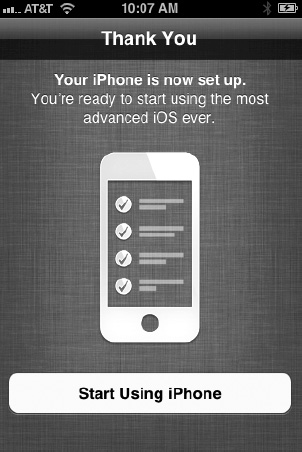
Figure 1–6. After answering a lot of questions, your iPhone is set up and ready to use. Tap the Start Using iPhone button to begin making calls, playing with apps, listening to music, watching videos, and doing the almost infinite number of things you can do with an iPhone.
Those aren't all the questions your iPhone will ask, however. For example, there's a screen that asks whether you want to enable Location Services. This allows applications to know your approximate location, which can be helpful if you're using a navigation app or annoying if you're using a third-party app that displays ads based on your location. I suggest turning on Location Services but then configuring your apps (Chapter 16) separately.
During the process, you'll also be asked whether you want to set up your iPhone as a new device, restore it from an iCloud backup, or restore it from an iTunes backup. If this is your first iPhone, the answer is simple—just set it up as a new iPhone. If you have previously owned an iPhone and made your backups to iTunes on a computer, tap the “restore from iTunes backup” button to get step-by-step instructions on how to reload all of your personal information, apps, and media from iTunes to the iPhone.
The newest feature allows you to restore your iPhone from an iCloud backup. If you had an iPhone 4 that you upgraded to iOS 5 and iCloud prior to purchasing a newer iPhone, chances are good that you allowed your phone to make automatic backups to iCloud. If this is the case, then tap the “restore from iCloud backup” button to restore your information, apps, and media to the iPhone.
Note that restoring your iPhone from the iCloud backup happens over a wireless connection. Even over a fast Wi-Fi network, the restoration of your data takes much longer than if you're restoring from an iTunes backup using a USB cable. This is a time-consuming process in either situation, so be patient, and you'll be rewarded with a fully loaded iPhone that's ready to roll.
Insuring and Repairing Your iPhone
Insurance plans for your iPhone can be offered by your mobile carrier, your insurance company, or Apple.
Your iPhone is covered under Apple's Limited Warranty for one year. That warranty covers problems with the device. If you drop your iPhone or lose it, you're out of luck unless you have additional insurance. You can add one extra year of iPhone AppleCare for $69. This extends your hardware repair coverage to two years in total. If interested, you can purchase this option online at the Apple Store (http://store.apple.com). Once the warranty has expired, your best bet is to have any repairs done at an authorized Apple repair center.
Beginning with the iPhone 4S, Apple now provides AppleCare+ ($99), which extends protection to accidental damage caused by dropping your device. AppleCare+ must be purchased at the time you buy your iPhone, and it extends repair coverage and technical support to two years from the original purchase date of your iPhone and adds coverage for up to two incidents of accidental damage because of handling, each subject to a $49 service fee.
With AppleCare+ for iPhone, Apple can troubleshoot issues over the phone or at an Apple Retail Store. If your iPhone needs service under the plan, Apple technical support representatives can set up a repair during the call.
If you can, be sure to back up your iPhone by syncing it to iTunes before bringing it in for service. Apple usually restores your iPhone to factory condition, which means you'll lose any data stored on the iPhone during the repair and service process. I recommend doing a backup and full erase of your iPhone before bringing it in for service so that the private information stored on the phone remains private. You can perform a full erase by selecting Settings ![]() General
General ![]() Reset
Reset ![]() Erase All Content and Settings.
Erase All Content and Settings.
Whether you buy an AppleCare protection plan or not, be aware that many mobile phone customers are provided with up to two years of complimentary telephone support (1–800-MY-IPHONE) during the term of their contract. You can find a complete list of ways to contact Apple Support at http://apple.com/support/contact.
Accessorizing Your iPhone
The iPhone accessory business is a huge and thriving economy. A visit to the iPhone accessories pages on the Apple online store shows just a small fraction of the iPhone cases, cables, docks, and other accessories that have been developed.
If you purchase your iPhone in an Apple Store, your Apple sales associate will show you many accessories that are available for it. These accessories are from Apple and third-party sources, and they provide your iPhone with protection and added functionality. Let's talk about some of the accessories that can make your iPhone experience more pleasant and fun.
iPhone Bumpers and Cases
One of the most popular categories of products for the iPhone consists of cases or, in the case of the iPhone 4 and 4S, bumpers. A case is exactly what it sounds like—something that encases the iPhone in fabric, plastic, carbon fiber, or metal to protect the phone from scratches or accidental damage because of a drop.
The phone-surrounding metal antenna of the iPhone 4 caused a stir when initial buyers of the phone complained of issues with signal strength. Apple responded shortly with an acknowledgment that most cell phones exhibit the same loss of signal when held a certain way by offering initial buyers a free iPhone 4 Bumper (Figure 1–7). The Bumper ($29) is an attractive two-tone band that wraps the external stainless steel antenna in hard plastic.
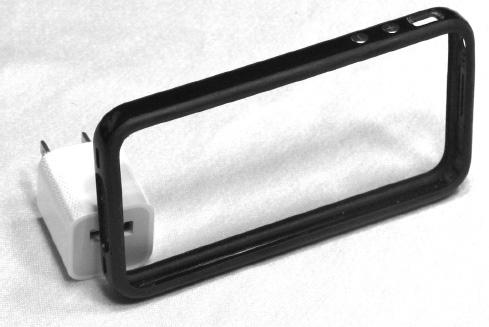
Figure 1–7. The Apple Bumper fits around the perimeter of the iPhone 4 or 4S, providing protection to the stainless steel antenna on the edges of the phone. That's the Apple USB Power Adapter at left, providing support to the iPhone 4 Bumper.
The iPhone 4 Bumper does not protect the screen or back of the iPhone. Those are made of hard aluminum-doped glass that is almost metallic in strength. The material can withstand impacts, can withstand drops, and is virtually scratch-proof, but that doesn't keep iPhone owners from wanting to protect their devices.
The iPhone 4S doesn't suffer from the same antenna issues, but a Bumper protects your investment just the same.
There are hundreds, if not thousands, of cases made for the entire family of iPhones. Some popular models are made by OtterBox (www.otterbox.com), LifeProof (www.lifeproof.com), Incipio (www.myincipio.com), Griffin (www.griffintechnology.com), and Marware (www.marware.com).
iPhone Skins
Skins are another popular form of protective gear for the iPhone. Instead of a thick shell of some other material encasing the device, skins stick to the iPhone like a second skin. Some are brightly decorated, while others are completely transparent.
Gela Skins (www.gelaskins.com) makes colorful designs from a number of artists, and you can also create your own designs from photos or original artwork. The skins are inexpensive, provide protection against scratches, and turn your iPhone into a movable feast of art (Figure 1–8).
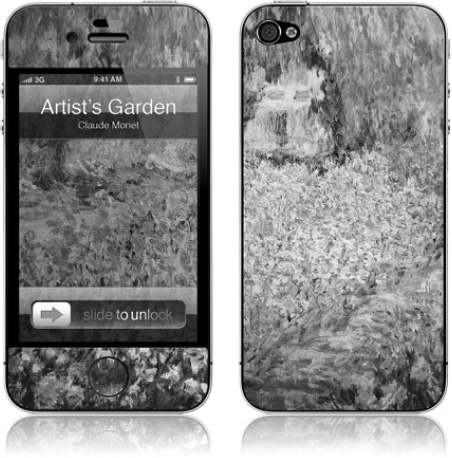
Figure 1–8. GelaSkins are one of several skins made for iPhone. These skins feature dynamic custom artwork designed for the company and classic art like “Artist's Garden at Giverny” by Claude Monet, but you can supply your own photos or art. Image courtesy GelaSkins.
Many other manufacturers are also making skins for the iPhone at this time, some of which dispense with artistic good looks in favor of invisible protection. Zagg (www.zagg.com) makes Invisible Shields that you can either install yourself or have installed for you at thousands of retail locations.
Power Adapters
Even though newer iPhones tend to get better battery life than the older models did, you still need to keep your battery charged. Apple sells the $29 USB Power Adapter (see Figure 1–6), which is exactly what comes with your new iPhone. Why would you want another one? It's always nice to have an extra to keep in your office for away-from-home charging or to take with you when you travel.
Speaking of travel, you'll want to keep your iPhone charged when you're in the car, so why not consider a car charger? Several models are popular, including the Griffin PowerJolt Plus ($24.99, Figure 1–9) and the Belkin Car Micro Charger ($19.99).
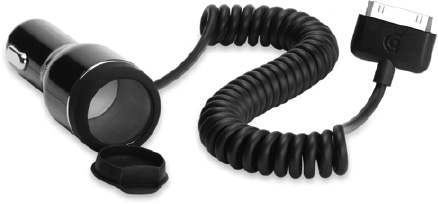
Figure 1–9. The Griffin PowerJolt Plus is one of a number of car chargers available for iPhone. Image courtesy of Griffin Technology.
Your computer can also charge your iPhone through the regular Dock Connector to USB cable that comes with the device. However, some people prefer the vertical orientation and ease of plug-in that comes with a dock.
Docks
Docks come in a variety of sizes, shapes, and capabilities. The most bare-bones dock that you'll find is the $29 Apple iPhone Dock, which allows you to place an iPhone onto the dock connector for charging and syncing while putting the device into a portrait orientation for easy viewing.
From there, your imagination and wallet are the limit. Higher-end models are equipped with speakers to turn your sleek little iPhone into a loud “clock radio” or boom box. The latter category is well represented by the $300 Harmon Kardon Go + Play Micro Portable Loudspeaker Dock for iPod and iPhone, while the former category is described by the Stem Innovation Time Command (http://steminnovation.com; Figure 1–10; $99.95).

Figure 1–10. Looking for something that can wake you up and charge your iPhone at the same time? This Stem Innovation Time Command dock is functional and looks good enough to sit on your nightstand.
Cables
Although the only cable you may ever need for your iPhone is the included USB-to-dock connector cable, there are other cables that can provide video-out functionality—perfect for watching photo slideshows or video stored on your iPhone on a big-screen TV.
Apple makes the Component AV Cable ($39) and Composite AV Cable ($39) for connecting an iPhone to either Component (Y, Pb, and Pr video and red/white analog audio ports) or Composite (composite video, red/white analog audio cables) television inputs.
The $29 Apple VGA Adapter also works with the iPhone 5, iPhone 4, and newer models to provide a VGA attachment to a television, projector, or VGA display.
CAUTION: Not all applications support these connection cables, so be sure to contact app developers for assurance that their app will drive your TV, projector, or display prior to purchase.
Summary
In this chapter, you've learned how to select and purchase your iPhone. You've discovered what's involved in activating your iPhone and become aware of the various service plans that you'll need to choose from. To wind things up, here is a quick overview of some key points from this chapter:
- Only a handful of iPhone models are available at any time. Whatever model you select, buying it at the Apple Store (retail or online) provides you with the best opportunities for returns and repairs if necessary.
- Make sure your computer is compatible with iTunes before you buy your iPhone by comparing it to the system requirements listed in this chapter. Remember, you don't need a computer to activate your iPhone, but if you want to keep it synced with your Mac or Windows PC, you'll need to sync via Wi-Fi or USB cable with iTunes.
- When activating, know in advance what kind of plans are available and which ones you want to use. Deciding in advance can save you many activation headaches.
- iPhones are not cheap. Protect your investment by insuring your phone. Also consider adding AppleCare for an additional year's coverage against hardware repairs or AppleCare+, which covers accidental damage to your iPhone for two years (subject to a $49 repair fee).
- iPhone technical support is free for two years. Take advantage of it at 1–800-MY-IPHONE (1–800-694-7466).
